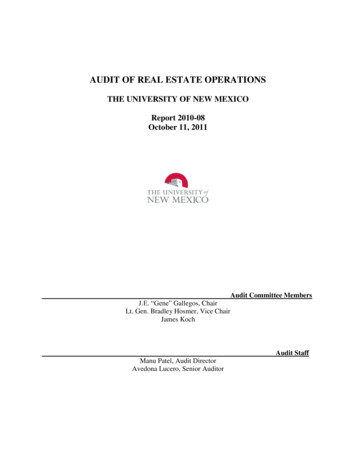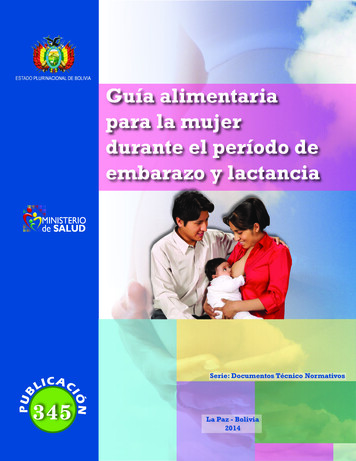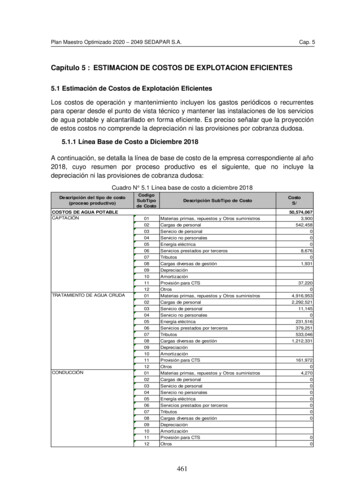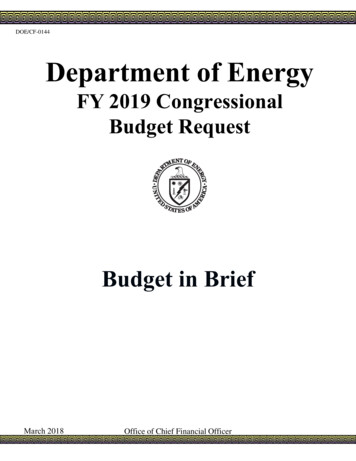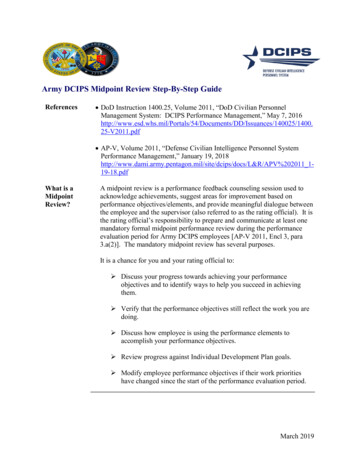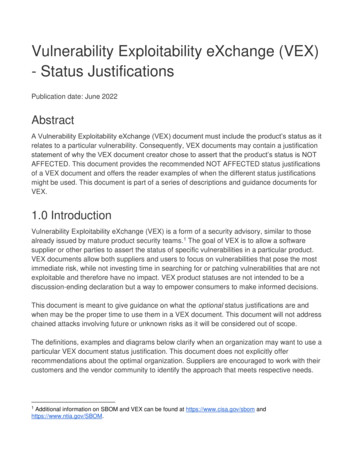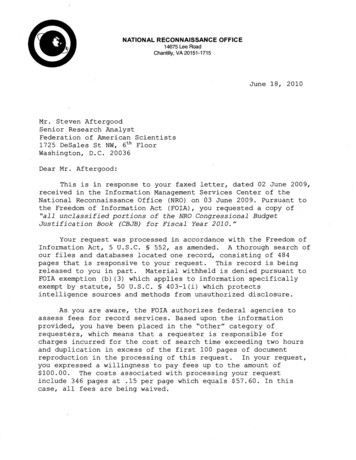
Transcription
NATIONAL RECONNAISSANCE OFFICE14675 Lee RoadChantilly, VA 20151-1715June 18, 2010Mr. Steven AftergoodSenior Research AnalystFederation of American Scientists1725 DeSales St NW, 6 th FloorWashington, D.C. 20036Dear Mr. Aftergood:This is in response to your faxed letter, dated 02 June 2009,received in the Information Management Services Center of theNational Reconnaissance Office (NRO) on 03 June 2009. Pursuant tothe Freedom of Information Act (FOIA), you requested a copy of"all unclassified portions of the NRO Congressional BudgetJustification Book (CBJB) for Fiscal Year 2010."Your request was processed in accordance with the Freedom ofInformation Act, 5 U.S.C. § 552, as amended. A thorough search ofour files and databases located one record, consisting of 484pages that is responsive to your request.This record is beingreleased to you in part. Material withheld is denied pursuant toFOIA exemption (b) (3) which applies to information specificallyexempt by statute, 50 U.S.C. § 403-1(i) which protectsintelligence sources and methods from unauthorized disclosure.As. you are aware, the FOIA authorizes federal agencies toassess fees for record services. Based upon the informationprovided, you have been placed in the "other" category ofrequesters, which means that a requester is responsible forcharges incurred for the cost of search time exceeding two hoursand duplication in excess of the first 100 pages of documentreproduction in the processing of this request.In your request,you expressed a willingness to pay fees up to the amount of 100.00. The costs associated with processing your requestinclude 346 pages at .15 per page which equals 57.60. In thiscase, all fees are being waived.
You have the right to appeal this determination by addressingyour appeal to the NRO Appeal Authority, 14675 Lee Road,Chantilly, VA 20151-1715 within 60 days of the above date.Shouldyou decide to do this, please explain the basis of your appeal.If you have any questions, please call the Requester ServiceCenter at (703) 227-9326 and reference case number F09-0087.Sincerely, .j. Sten R. Glenn C ief, Information AccessAnd Release Teamt?Attachment:NRO FY 2010 CBJB (484 pgs)
Access to the information in this document is restricted to US citizens withactive SCI accesses for COMINT and TALENT-KEYHOLE information.DISSEMINATION CONTROL ABBREVIATIONSNOFORN - Not Releasable to Foreign NationalsThis Component Budget of the National Intelligence Program isproduced pursuant to provisions of Executive Order 12333, asamended by Executive Order 13470, and section 102A(c) of theNational Security Act of 1947, as amended.NATIONAL SECURITY INFORMATIONUnauthorized Disclosure Subject to Criminal SanctionsNRD Approved For ReleaseTOP SECRETllSIlTK//NOfOItN """""
National Intelligence ProgramFY 2010Congressional Budget JustificationVolume IVNational Reconnaissance ProgramMay 2009'fOil S!eAETh'Slffl6'I'NeFOANDRV FROM: NeG 6.0, 21 May 2005OECL ON: 25Xl. 20590504RRG dated July 05NRO Approved For Release
'f6f'S!e !l'ilSlfFl eFe N(U) CONTENTSPage(U) OVERVmW . .1Page(U) SPACE COMMUNICATIONS. . . . . . . . . . . .(U) COLLECTION AND OPERATIONS8997(U) GEOINT EO . .17(U) Enhanced Imagery System . .21(U) Space Operations Development Segment. . . . . . . . . . . . . .105(U) Next Generation EO . .25(U) Relay Readiness and Launch .109(U) EO Integration & Support . .27(U) Space Communications Integration & Support .113(U) Mission System Encryption .11735(U) LAUNCH.121(U) GEOINT Radar Sustainment . .39(U) Launch Vehicles .125(U) Radar Integration & Support . .41(U) Launch Capability Infrastructure. . . . . . . . . . . . . . . . .129(U) Launch Operations & Engineering . . . . . . . . . . . . . . . . . . .131(U) GEOINT RADAR . . .10129(U) SIGINT LOW . .(U) PROCESSING AND EXPLOITATION(U) Low Altitude Integration & Support . .(U) SIGINT HIGH . .(U) High Altitude Integration & Support . .iii53(U) GEOINT/SIGINT INTEGRATED GROUNDDEVELOPMENT & ENGINEERING MANAGEMENT .13557(U) UGA Ground Development .14371(U) UGA Processing Development .14775(U) UGA Processing Development OCO .15179(U) UGA EnteIprise Development .15383(U) Ground Integration & Support .15785(U) Deployed Support .161TeP SEORETh'SIR"ltltNorORNNRO Approved For Release
TOP S!efiU!Tff5lmtm40POP\14PagePage(U) MISSION GROUND STATIONS .165(U) Human Resources . . . . . . . . . . . . . . . . . . . . . . . . . . . . . . . .243- JJ CONUS Operations . . . . . . . . . . . . . . . . . . . . . . . . . . . . . .179(U) NRO Mission Support .247. . . .183(U) NRO Mission Supportoeo . . . . . . . . . . . . . . . . . . .251(U) Station Integration & Support . . . . . . . . . . . . . . . . . . . . .187(U) Security . . . . . . . . . . . . . . . . . . . . . . . . . . . . . . . . . . . . . . . .253(U//FOU Spectrum Management .257(U) Systems Engineering .261(U) FACILITIES AND LOGISTICS .265(U) Facilities . . . . . . . . . . . . .269(U) Logistics . . . . . . . . . . . . . . . . . . . . . . . . .273(U) ACQUISITION SUMMARY. . . . . . . . . . . . . . . . . . . . . . . .277 rationsBOOK 2(U) ENTERPRISE IT(U) ENTERPRISE IT SYSTEMS. . . . . . . . . . . . . . . . . . . . . . .191(U) Connectivity .197(U) Enterprise Architecture & Planning .20 I(U) Information Assurance .:.205(U) RESEARCH AND 'IECHNOLOGY(U) SPECIAL TOPICS(U) RESEARCH AND 'IECHNOLOGY .209(U) Functional Availability . , . . . . . . . . . . . . . . . .305(U) Research & Technology Development. . . . . .215(U) NRO Ground Transformation . . . . . . . . . . . . . . . . . . . . . . .323(U) Research & Technology Support. . . . . . . . . . . . . . . . . . . .221(U) Supplemental Funds Moved to Base .327(U) CONGRESSIONAL REPROGRAMMING ACTIONS. .329(U) OMB PROGRAM ASSESSMENT SUMMARY. . . . . . . .331(U) RESOURCE EXHIBITS .375(U) R SERIES, P SERIES EXHIBITS .389(U) GLOSSARY479(U) ENTERPRISE MANAGEMENT AND SUPPORT(U) ENTERPRISE MANAGEMENT .223(U) Acquisition Management. . . . . . . . . . . . . . . . . . . . .231(U)Education&TraUllng . .235(U) Finance . .237(U) HQ Management . .239ivNRO Approved For Release
"FOP SEeAETf"Slffl6'lI eFO"I (U) PROGRAM OVERVIEW(U) Description(U) The NRO brings unique cOre capabilities to bear in support ofnational security objectives by:(U) In times of heightened tension, crisis, or even humanitarian ornatural disasters. the value of NRO systems is even greater. At this time,NRO systems are not only the ftrst responders of choice for the DoD, Ie,or key decisionmakers - they are often the only source of information. (U) Acquiring and operating the most capable set of satelliteintelligence collection platforms ever built. (U) Providing a variety of special ground processing applicationsand tools to support the Ie and DoD.(U) The US is arguably more reliant on overhead collection than everbefore. To a large extent, satellite reconnaissance is the foundation forglobal situational awareness, and as such, it is an essential underpinningof the entire US intelligence effort. Space collection provides uniqueaccess to otherwise denied areas to provide persistent and responsivecollection; and it does so without risk to human collectors or infringingupon the territorial sovereignty of other nations. It also enables users toquickly focus on almost any point on the globe to rapidly respond toemerging situations or to monitor ongoing events. The NRO providesdirect support to the war on terrorism, deployed military forces, andother Ie and DoD activities requiring near real-time situationalawareness and sustained high resolution/high sensitivity collectioncapability 24-hours-a-day, 7-days-per-week.1(U) Strategic Direction(U) The 2009 National Reconnaissance Strategic Plan defines a newvalue model for the NRO: the NRO is now focused as much on what itdoes with the data it collects as it is on collecting it; and programs mustmake good business sense as well as good technical sense. In addition tocontinuing to design and build state-of-the-art satellites that provideunparalleled information advantage for the Nation and our users, theemphasis is on accelerating the delivery of innovative groundcapabilities that amplify overhead capabilities and that are moreresponsive to dynamic and rapidly changing user needs. The NRO isworking to implement fully integrated space and ground architecturescharacterized by synergistic, cross-domain mission management,multi-INT data fusion at the source, common processing, and closerlinkages with other Ie and DoD technical architectures and functions.The NRO is also leveraging its extensive ability to move data, both onthe ground and in space, to enable its mission partners to moreeffectively execute their missions.(U) The NRO is moving in new directions while continuing to buildon its heritage. The 2009 Strategic Plan establishes the corporateframework for planning and executing the technical initiatives requiredto achieve the NRO's long-term goals and objectives. It definesoverarching corporate imperatives that are fundamental to theorganization's success; it establishes investment guidelines forengineering and budget planning; and it defines new corporate technicalpriorities to guide lower-level program development. Equallysignificant, it recognizes the most critical element in the NRO'slong-term success is its workforce.Tefl SI!6AETf;'SlffitiINOPeANNRO Approved For Release
'fOp SEORE'f/lSlffltlIf48F8RN(U) The NRO is reestablishing its reputation for on-time andon-budget delivery. It is also focusing on delivering the best long-termvalue for the systems it builds. This includes a heightened emphasis onthe health of the national security space industrial base that the NROultimately depends on for its long-term success. The NRO is alsoworking to improve the protection and survivability posture of its spaceand ground assets. (U) A new Chief Operating Officer position focused on deliveringNRO programs to their established cost, schedule, and performancebaselines. (U) A new corporate systems engineering function to enablecross-INT trades and enterprise-level planning. (U) A new Ground Enterprise Directorate focused on synergisticground development, the development of integrated taskingcapabilities, and the production of fused products.(U) To support this ambitious vision, the NRO recently completed acomprehensive realignment of its corporate governance structure as wellas a complete reassessment and redefinition of its acquisitionmanagement processes and a reorganization of its acquisition andoperations-related functions. These initiatives are collectively referred toas the NRO Transformation and they fundamentally change the way theNRO manages itself and the way it executes its mission.(U) The Transformation also includes a complete reassessment of allacquisition-related policies, processes, and documentation. Where gapswere found, they were addressed; where best practices were found, theywere baselined for the entire organization; and where improvementscould be made they were made.(U) The NRO Transformation is arguably the most ambitiousorganizational, business process, and management realignment in thehistory of the NRO. The !NT-based organizational and managementapproach that had been the foundation of the NRO's structure for thepast 40 years has been replaced with a functionally-based structure that,for the first time, enables us to manage ourselves and our systems assingle integrated entity. In addition, all systems engineering andacquisition management functions are now enveloped within a single setof standardized best-practices and performance measures. TheTransformation also implemented rigorous engineering, programmatic,and management checks and balances at all levels within theorganization.(U) Although the management and engineering structures andprocesses are now in place to facilitate moving into a new era, in thefinal analysis, the NRO can only be as effective as its workforce. Peopleare our most important asset. The NRO is working hard to recover fromthe adverse impacts of the acquisition "reform" and "peace dividend"eras of the 1990s. During this era, the NRO essentially lost a generationof project managers and systems engineers. We now have programmanagers who are superbly well qualified technically, but who lack thehands-on program management experience essential for completedevelopment. This loss, coupled with· the retirement surge beingexperienced by all government agencies, creates a particularlychallenging workforce environment for the NRO.(U) The Transformation implements the changes necessary to restoreacquisition discipline and accountability. EqualJy important, itestablishes the framework and provides tools to more effectivelyintegrate NRO systems into larger IC architectures and to synergisticallyalign NRO with other collectors.(U) To address these staffing challenges, the NRO is taking the initialsteps to establish a separate NRO Career Service to augment existingstaffing agreements. The NRO is currently totally reliant on outsideorganizations to meet its mission-critical staffing requirements.Although our mission partners continue to be supportive, resources arestretched and outside organizational priorities continue to evolve anddiverge, putting NRO mission execution at risk. The NRO career servicewill provide a buffer from these risks. Equally important it will providesome level of management continuity, workforce stability, and the(U) In the aggregate, the Transformation establishes: (U) A new corporate governance structure with unambiguous anddocumented lines of personal resIX nsibility and accountability.2"FOP SEsnE"FIISIJTIflINOFOR' NRO Approved For Release
,eli SEeAET/IStrFIEfH40FeRNability to recruit, reward, and promote personnel consistent with theNRO's unique mission requirements. Initial funding to support thiscareer service is incorporated into our FY 2010(U) Conclusion(U) The NRP's FY 2010 request, in concert with the FY 2008Agency Financial Reports provided in November 2008, and theFY 2008 NIP Citizen's Report and NIP Annual Performance Reportprovided separately in January 2009, meets the requirement for theannual performance and accountability reporting requirement for the Ie.The NRP is committed to demonstrating that resources producemeasurable results. Relationships between resources, results, andperformance are highlighted throughout the request.NRO Approved For Release3lOP SEOAETh'SIR"IEfIHOf'ORf4.".".".,'""'-""'''-, . ,,-, . --,-------
Tep SeeAEftlSlfFliI'''.OFORtl(U) Budget Request Highlightsservices to meet mission critical staffing requirements; however,resource restraints and evolving priorities have resulted in reduced fillrates and shortened tenure in mission critical occupations.( 30 positions) (U) As part of the NRO Transformation, the NRO is centraIizingsystem engineering across the organization to improve overalleffectiveness. As a result a new, consolidated System Engineeringproject has been created within the Enterprise ManagementExpenditure Center, subsuming three legacy projects along withactivities and resources from several other NRO budget projects.(U) New Initiatives: (U) The NRO is augmenting its current staffing model with 100NRO career service employees to provide critical space acquisitionskills and experience (engineering, program management,contracting, and program control). These DoD personnel will beadded over a three year period (30 in FY 2010,40 in FY 2011, and 30in FY 2012). The NRO is currently re1iant on external agencies and (U) To improve the flexibility and responsiveness of the R&Dportfolio. the NRO has consolidated its three Advanced R&D projectsin to a single Research and Technology project.NRO Approved For Release5'FOP SreAE"FOStfFlflIN6FeF.,4
"FOPeEeREllleIR l INOFORt4(0) Significant Increases from FY 2009 to FY 2010:(U) Significant Decreases from FY 2009 to FY 2010: (Ut'tFOUO, Purchases two launch services vice one in FY 2009 andreinstates the NRO's 30 percent share of the Enhanced ExpendableLaunch Vehiclecontract that was transferred toAir Force in 2009. 4 FI'Es, -1 military position). . ",I. . . . Ll,. NRO Approved For Release6-. -.- .---------
"FOP SEOREl'h'SIt:rWJNOFORN(U) Funding for NationallnteUigence Strategy Mission Objectives(U) Management Oversight(U) Management oversight for the NRO is providedby:. (U) The Office of Management and Budget. (U) The Director of National Intelligence. (U) The Secretary· of Defense.(U/IFOUO) Four of the MOs - Counterterrorism (CT), ocracy(Democratization), and Anticipate Strategic Threats and IdentifyOpportunitieslVulnerabilities (Strategic Threats) are closely alignedwith the Presidentially-approved National Intelligence PrioritiesFramework (NIPF). Figure 2 shows funding for the MOs as they relateto the NIPF topics and Figure 3 shows resources for each MO by budgetcategory.NRO Approved For Release7"FOP SEGRET/.'SIt:rI"INOFGRN
1'011 Seefte'f;;StffltlIt4eFeftN(U) FY 2010 Workforce HighlightsCU) A key initiative for recruitment and staffing is for the NRO tocontinue its effort to establish its own, distinct career service. Thisinitiative will provide management continuity, workforce stability,long-term perspective, and critical space-acquisition skills andexperience (engineering, program management, contracting, budgeting)to execute the NRO mission. The NRO will develop an implementationplan that provides for support. and servicing of this new workforceelement, as well as the distribution of these positions across the NROenterprise.(U) NRO Civilian Employment Plan(U) The Consolidated Employment Plan concept currently focuses oncivilian positions and personnel funded by each agency. Innovativehuman resource programs are needed to support the NRO's"cradle-to-grave" approach to space systems management. It isimperative for the NRO to have a workforce that is both conversant withthe satellite life-cycle and available for longer assignments. The NROworkforce utilization requires fluid human resource processes andprograms that are uncharacteristic of most federal organizations.Initiatives are underway that will provide a comprehensive andmission-focused corporate strategy to ensure the NRO has the rightworkforce to meet its evolving mission. The following paragraphsaddress the initiatives in greater detail.10(U) Implement a Corporate Approach to Workforce Analysis andPlanning Aligned to Mission Imperatives: The NRO will conductworkforce analysis of the NRO core mission occupations. Theworkforce will be assessed along occupational lines, taking into accountparent agency demographics, trends and workforce initiatives. The endresult will be workforce planning that is coordinated and integrated byoccupation across the parent agencies. Furthermore, the NRO willpromote a consistent approach toward developing an acquisitionworkforce that is highly trained, capable, and meets certificationrequirements established by each parent agency. In order to accomplishthis, the NRO established an NRO Acquisition Workforce DevelopmentBoard that will serve as the NRO focal point for developing, promoting,and overseeing coherent policies and processes across the NRO toproactively recruit, develop, and retain its acquisition personnel.(U) Acquire the diverse, high-quality workforce required to meetNRO mission imperatives: A key initiative for recruitment and staffingis the proposal to augment NRO staffing with 100 NRO career serviceemployees. This initiative will provide management continuity,workforce stability, long-term perspective, and critical space-acquisitionskills/experience (engineering, program management, contracting,budgeting) to execute the NRO mission. In addition, the NRO willimplement a corporate, integrated Strategic Staffing Strategy to ensurethe organization is staffed with high-caliber technical, non-technical,and support personnel. The Strategic Staffing Strategy will align staffingwith business goals, calculating costs, defining requirements, andmeasuring the effectiveness of decisions. It provides for aggressive"marketing" initiatives to expand DoD and Ie awareness of the NROmission and career opportunities. These initiatives will help identify adiverse pool of individuals with specific talents and skill sets to fillcurrent and projected NRO mission requirements.(U) Lead and develop the workforce to achieve peakperformance: The NRO must ensure that its employees receivetraining, education, and development opportunities directly relevant toNRO's mission, and must consider the development of its transientworkforce as future leaders and employees of the IC. The NRO willdesign, develop, and deliver leadership and professional-developmentprograms to meet the needs of its workforce and align to leadership anddiscipline competencies published by the ODNI. Therefore, the NROwill engage with parent elements in developing the workforce through'FOP eEeAET/f9llfltllNeFeftr NRO Approved For Release
lOP SEOREltlSIITIEIlt40FefU4the Talent Management Initiative. We will sustain an Air Force-NROAssignment Planning Board to assess Air Force officers at the two-yearpoint for internal moves that are intended to complement careerprogression. The NRO will continue to use the Workforce ManagementBoard to oversee the CIA workforce that ensures equitable distributionof CIA employees/positions to fIll high-priority mission requirements.(U) Sustain and retain a peak-performing workforce committedto the mission: In the coming years, the NRO is implementing andmaintaining compensation and ,performance management systems thatare specific to each parent agency (Defense Civilian IntelligencePersonnel System. National Security Personnel System, CIA, DNI, etc).Tailored training courses on each pay-for-performance system are underdevelopment to prepare managers and supervisors for managing anddeveloping each segment of the workforce in a manner that maintainsthe integrity of the systems. The NRO will also provide transformationsupport to senior managers through a leadership development programthat wilJ give them the requisite skills to be successful change agents in achanging environment.(U) NRO Employment Demographics(U) Grade Distribution by Age: The NRO grade distribution is areflection of the technical expertise required to achieve its space missionwith a majority of the workforce residing in the senior grades: OS-13thru senior executives. Furthermore, the NRO average age is consistentwith the trend in the federal government with NRO employees in thelate-40's to mid-50's bracket holding senior ranking positions with 15plus years of service.(U) Retirement: As is the ca in many federal organizations, thenumber of new employees, in tenus of occupation experience, and thenumber of experienced officers eligible or approaching eligibility forretirement are growing. Of the NRO current workforce, 53 percent areeligible or will become eligible to retire in the next 10 years; and30 percent have five years or less experience with their parent agencies.Each mission area could be impacted if retirement-eligible governmentcivilians were to retire en masse.(U) Workforce Positions: The NRO is requesting authorization for100 additional NRO DoD PTE to establish a separate NRO civiliancareer service and to improve the execution of its mission. Thesepersonnel will support the hiring and long-term development ofpersonnel for the mission critical occupations-engineering, programmanagement, contracting, and budgeting. The 100 FTE will be phased inover the course of three fiscal years beginning in FY 2010.(U) NRP Workforce Positions by Budget Category: The NROworkforce distribution reflects the primary role that acquisition plays inthe NRO mission. A majority of civilian employees work in missionsupport occupations and the remaining civilians work in core missionareas: research and development, engineering, information technology,and operations. Forty-seven percent of the NRO total positions arealigned under the Enterprise Management and Support budget categorywhich includes acquisition professionals.(U) Staffing and Demographic Thends: NRO fill rates havedeclined over the period FY 2005 - FY 2008 from an annual average of86 percent to 85 percent for civilian positions and 88 percent to82 percent for military positions. Fill rates vary by parent agency andoccupation and reflect parent agency workforce initiatives and capacityto maintain pace with NRO position growth. Even though the NRObudgets for position growth, the ability to fill new positions depends onwhether the parent agencies can support increased personnel demand.(U) In the past, Air Force military assignments were four year toursexempt from deployment. Due to policy changes and organizationalrestructuring of Air Force personnel assigned to the NRO, military toursare no longer exempt from deployments and the historical 100 percentfill rate policy has been impacted by more stringent guidelines for AirForce assignments. Oiven that the Air Force military personnel accountfor signiftcant portions of NRO mission critical occupations (ie.,34 percent of acquisitions and engineers, 55 percent of operations, and78 percent of information technology), any decrease in manning rateswill impact NRO's mission capabilities.(U) The NRO government civilian population consists primarily oftechnical occupations. As such, the NRO grade distribution isappropriate for the experience and education level required for technicaloccupations. The civilian population within OS-12 and above grades"FOP 8E9AETIf911T1 INOFOFtN11'. -"--,,.--- .----NRO Approved For Release
"FOP SE9AET/fSlfTltlJNOFeAN(77 percent) has an average of seven years of NRO service. The moresenior positions (GS-14s and above) have a greater average length ofservice at the NRO. However, new arrivals to the NRO from FY 2003 FY 2008 have less experience with their parent agencies in contrast tothose who arrived between FY 1997 - FY 2002."FOP SEeRET{JSlfFl Jt40FOAt412NRO Approved For Release.- . ----
TOta SEOftEl'IfSlffltliNOFOAt4(U) Workforce Infrastructure and Support (U) Complete deployment of Phase II of e-Trip, the travelmanagement software for all NRO government employees, fullyincorporating financial "fast pay" and automated statistical samplingprogram for domestic travel vouchers.16lOta SEOftEl'IfSIRltl/NOFOANNRO Approved For Release
'fOP SEOAE'fIlSllfIElJt40FOAN(U) ENHANCED IMAGERY SYSTEM(U) Project Description(U) The NRO expects the project to accomplish the following inFY2009:(U) The NRO expects the project to accomplish the following inFY2010:. - . . .---!---- . .!. .- .!--!21NRO Approved For Release
TOP SEeAEf:fSlfft "40FOAN(U) Significant Increases from FY 2009 to FY 2010:(U) There are no significant increases in this project for FY 2010.(U) Significant Decreases fromFY 2009 to FY 2010: JI22lOP SEGAET!JSI,q:KlJt OFOANNRO Approved For Release
"FOP 6EGnETII6I1T1 "'40FOn'4(U) NEXT GENERATION EO(U) Project Description (U) Associated systems engineering activities; ContractedAdvisory and Assistance Services/System Engineering and TechnicalAnalysis (eAAS/SETA); FFRDC support; and trade studies andanalyses.(U) The NRO expects the project to accomplish the following inFY2009: (U) Prepare for and conduct milestone A and begin phase A. (U) Ground system integration.25(U) The NRO expects the project to accomplish the following inFY 2010-continue risk reduction, long lead procurement, anddevelopment for NGEO space and ground.'fOP 9EOFlEli'iSIRWIP40FORNNRO Approved For Release
l'OP SEOflEl'/lSb'fIElINOFOflN(U) Significant Decreases from FY 2009 to FY 2010:(U) Significant Increases from FY 2009 to FY 2010:(U) There are no significant increases in this project for FY 20 lO.may not(U) All personnel doUars are incorporated in the EnterpriseEC, Human Resources project(U) MilPers funding is within the applicable military department budget.(U) ClAP personnel are detailed to the NRO but authorized and budgeted within the ClAP.NRO Approved For Release26"FOP SEOflETflSlfFIEIR40FOflr4
"FOP SESAEl;'l8lfFl }NOFOAt.(U) EO INTEGRATION & SUPPORT(U) Project Description' "),1(U) The NRO expects the project to accomplish the following inFY 2010: (U) System trade studies. (U) Requirements analysis. (U) Prime contractor design evaluation. (U) Modeling and simulation. (U) Program and business management support.(U) Significant Increases from FY 2009 to FY 2010: (U) Integration and test support. (U) Acquisition support activities such as engineering changeproposals and acquisition planning.(U) The NRO expects the project to accomplish the following inFY2009:(U) Significant Decreases from FY 2009 to FY 2010:(U) There are no significant decreases in this project for FY 2010.NRO Approved For Release27'fOP SeeAEl'/"SlfFlEI" OFOAN
oP SESRCFlJSIITI RIIIOFOAH(U) GEOINT RADAR SUSTAINMENT(U) Project Description(U) Resources in the GEOINT Rada
Justification Book (CBJB) for Fiscal Year 2010." Your request was processed in accordance with the Freedom of Information Act, 5 U.S.C. § 552, as amended. A thorough search of our files and databases located one record, consisting of 484 pages that is responsive to your request. This record is being released to you in part.

